Pain Management for Herniated Discs: A Comprehensive Treatment Guide
Understanding Herniated Disc Pain and Your Treatment Options
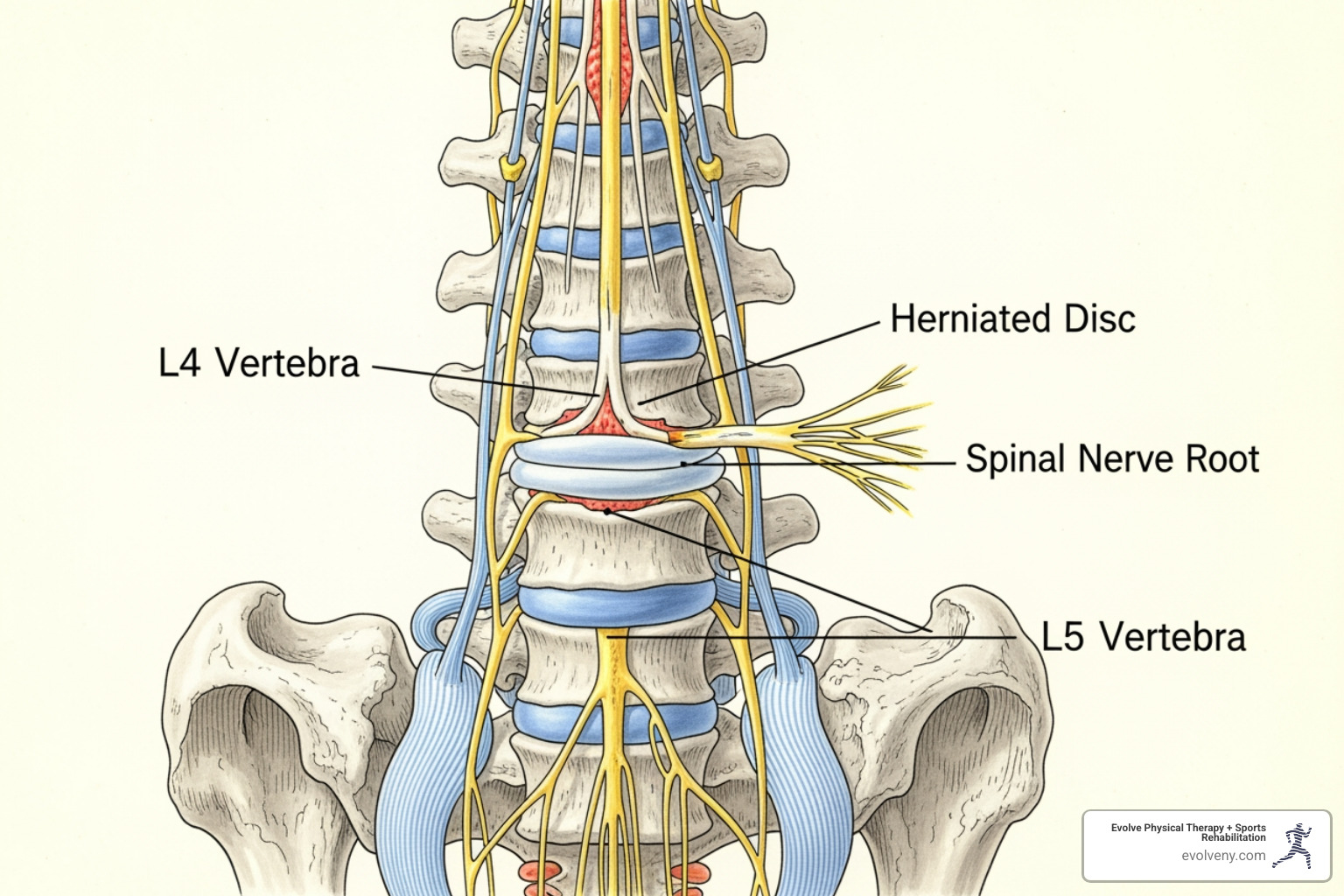
Pain management herniated disc treatment begins with understanding your condition and options. A herniated disc occurs when the soft, gel-like center (nucleus pulposus) of a spinal disc pushes through a crack in its tough outer layer (annulus fibrosus). This can press on nearby nerves, causing pain, numbness, or weakness that radiates down your leg (sciatica) or arm.
Most herniated discs occur in the lumbar spine (lower back), followed by the cervical spine (neck). While the pain can be debilitating, the prognosis is excellent. Over 85% of people improve within 8-12 weeks with conservative treatment, and surgery is rarely needed.
Effective Non-Surgical Treatments:
- Physical Therapy: Strengthens core muscles and relieves nerve pressure.
- NSAIDs: Reduces inflammation and pain (e.g., ibuprofen).
- Epidural Steroid Injections: Delivers targeted anti-inflammatory medication.
- Activity Modification: Avoiding movements that worsen pain while staying active.
- Manual Therapy: Hands-on techniques to improve mobility and reduce symptoms.
Surgery is typically only considered if conservative treatment fails after six weeks, or in cases of progressive muscle weakness or loss of bladder/bowel control (an emergency).
I'm Lou Ezrick, founder of Evolve Physical Therapy in Brooklyn. With nearly two decades specializing in pain management herniated disc treatment, I've seen how personalized, hands-on therapy helps thousands of New Yorkers avoid surgery and return to the activities they love.
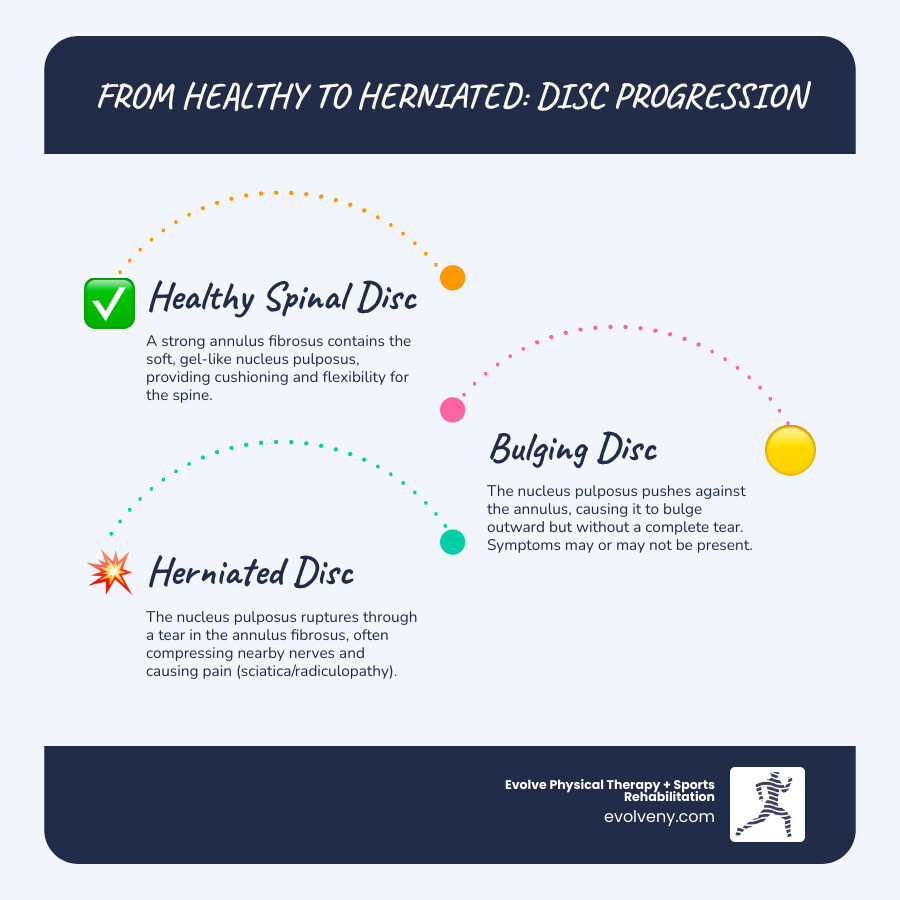
How Herniated Discs Are Diagnosed
An accurate diagnosis is the first step toward relief. At Evolve Physical Therapy, we work with your doctor to pinpoint the cause of your pain through a combination of physical examination and advanced imaging.
A medical doctor will perform a physical and neurological exam, which includes:
- Muscle Strength Tests: To identify weakness caused by nerve compression.
- Sensation Tests: To map out numbness or tingling along nerve pathways.
- Reflex Testing: A diminished reflex can indicate a pinched nerve.
- Straight Leg Raise (SLR) Test: For lower back herniations, this test can reveal nerve root irritation if it causes pain to shoot down your leg.
While physical tests provide valuable clues, imaging confirms the diagnosis.
- MRI (Magnetic Resonance Imaging): The gold standard for diagnosing herniated discs. It uses magnetic fields to create detailed images of soft tissues like discs and nerves, showing exactly where compression is occurring.
- CT Scan: Provides cross-sectional images of the spine and is useful for viewing bone structures and discs.
- Myelogram: A CT scan performed after injecting dye into the spinal fluid to highlight pressure on the spinal cord or nerves.
- X-rays: Cannot show herniated discs but are used to rule out other problems like fractures or spinal alignment issues.
Combining a physical exam with detailed imaging allows your medical team to create the most effective pain management herniated disc strategy for you.
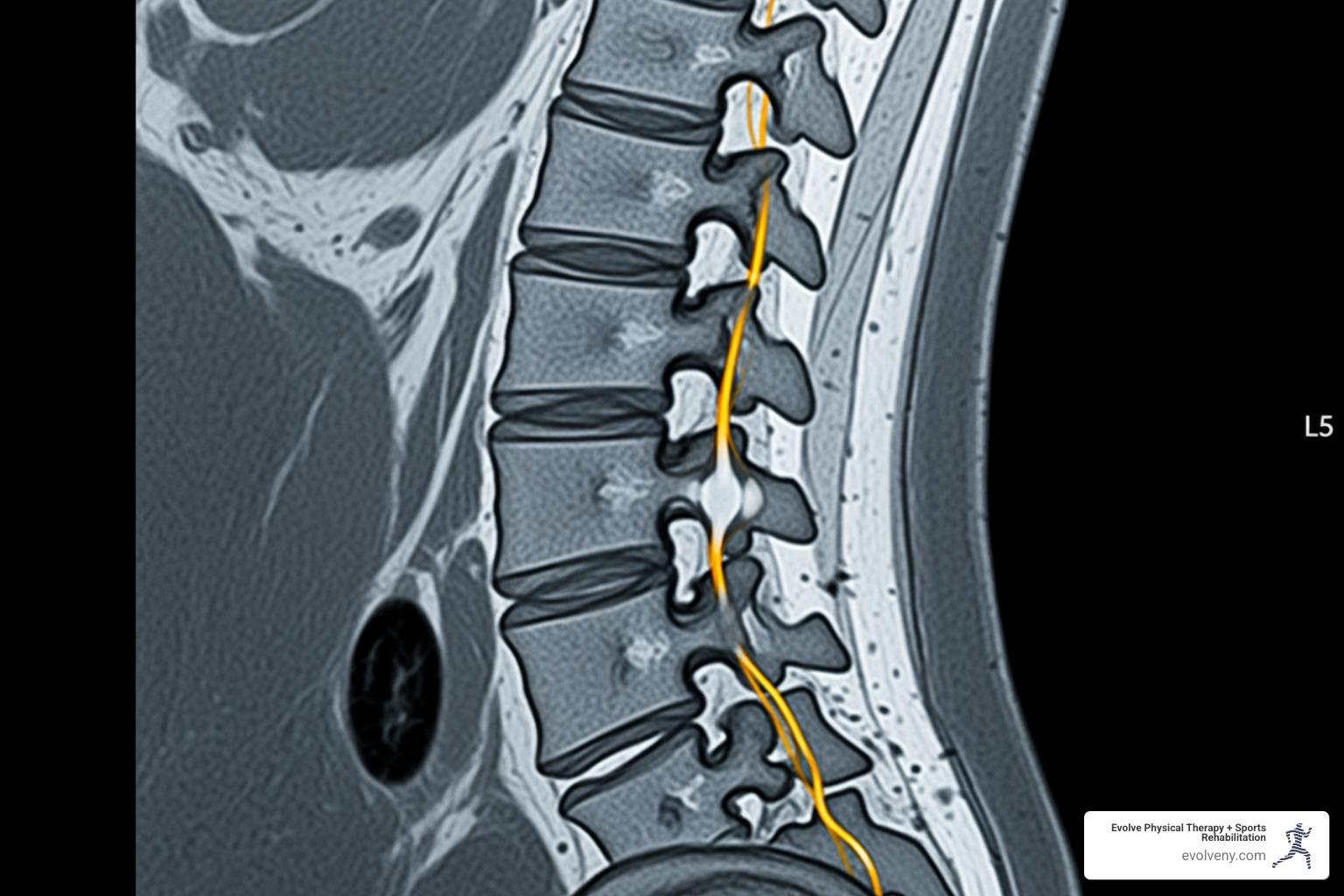
Comprehensive Pain Management for a Herniated Disc: Non-Surgical Options
The great news is that you likely won't need surgery. Over 85% of acute herniated disc symptoms resolve within 8 to 12 weeks with conservative treatment. The foundation of effective pain management herniated disc treatment is staying active. While it seems counterintuitive, staying active is far more essential to recovery than bed rest.
Activity modification is key: listen to your body and temporarily avoid heavy lifting, twisting, and prolonged sitting. The goal is to modify, not eliminate, activity to allow your spine to heal.
The Crucial Role of Physical Therapy
Physical therapy is often the most powerful tool for recovery. At Evolve Physical Therapy in Brooklyn, our hands-on care addresses the root cause of your pain for lasting relief.
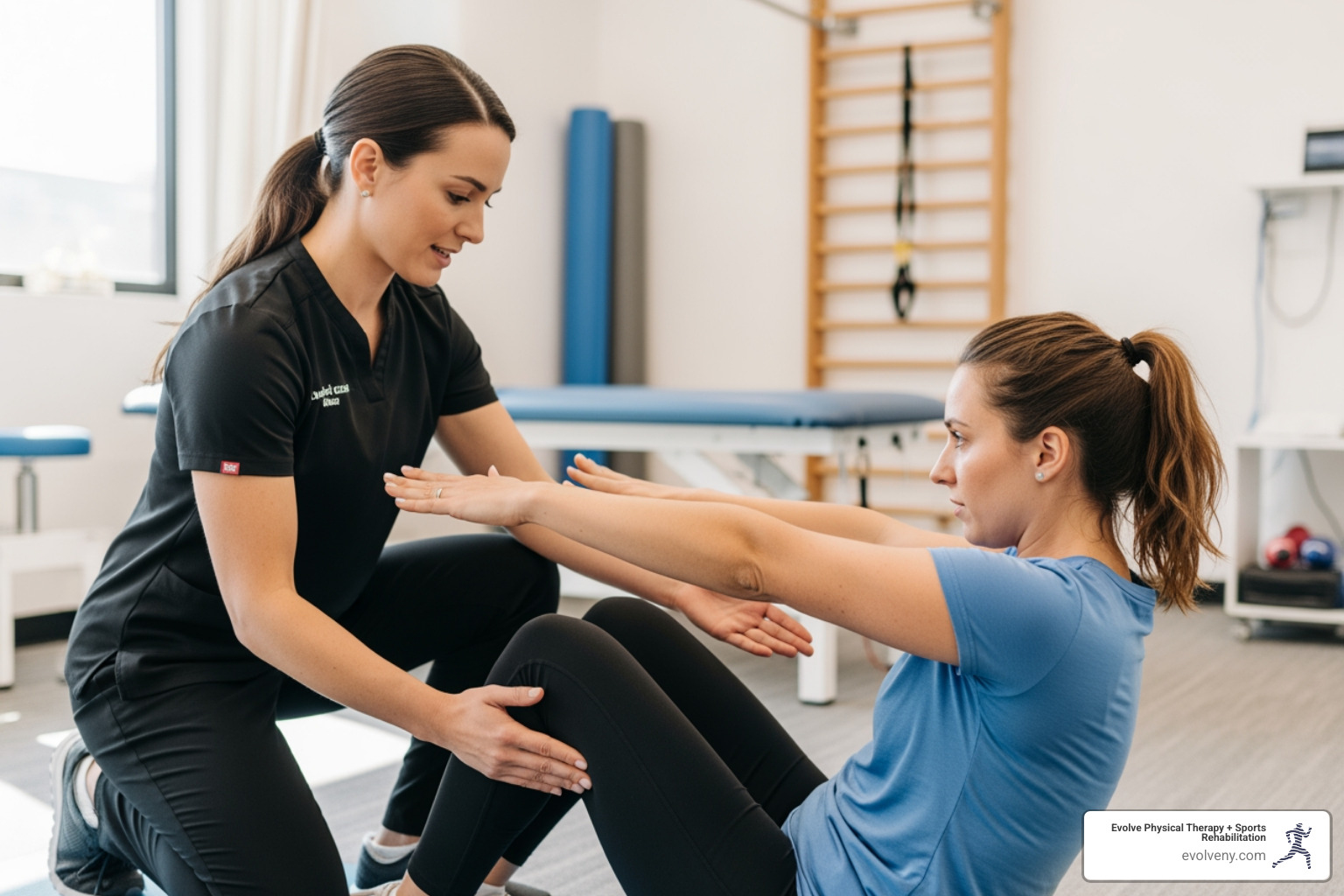
A physical therapist will guide you through a program focused on:
- Pain Relief: Using techniques to reduce nerve irritation and muscle spasms.
- Core Strengthening: Building a natural support system for your spine to take pressure off the injured disc.
- Posture Improvement: Correcting daily habits that strain your discs.
- Flexibility: Using gentle stretching to improve range of motion and reduce tension.
Our Brooklyn team specializes in manual therapy combined with targeted exercises. This approach, detailed in our Physical Therapy for Herniated and Bulging Discs Brooklyn and Back Pain Physical Therapy Brooklyn programs, has helped thousands avoid surgery.
Medication-Based Pain Management
Medication can reduce inflammation and pain, enabling you to participate in physical therapy.
- Over-the-counter NSAIDs: Ibuprofen (Advil) or naproxen (Aleve) are a first-line defense against inflammation.
- Prescription Medications: Your doctor may prescribe muscle relaxants, oral corticosteroids for powerful anti-inflammatory effects, or anticonvulsants (like gabapentin) for nerve pain.
- Tricyclic Antidepressants: These can be effective for chronic pain as they increase neurotransmitters in your spine that relieve pain.
- Opioids: Used cautiously for severe, short-term pain only, due to their addictive nature.
Advanced Pain Management: Injections
When other methods aren't enough, injections deliver powerful anti-inflammatory medication directly to the pain source.
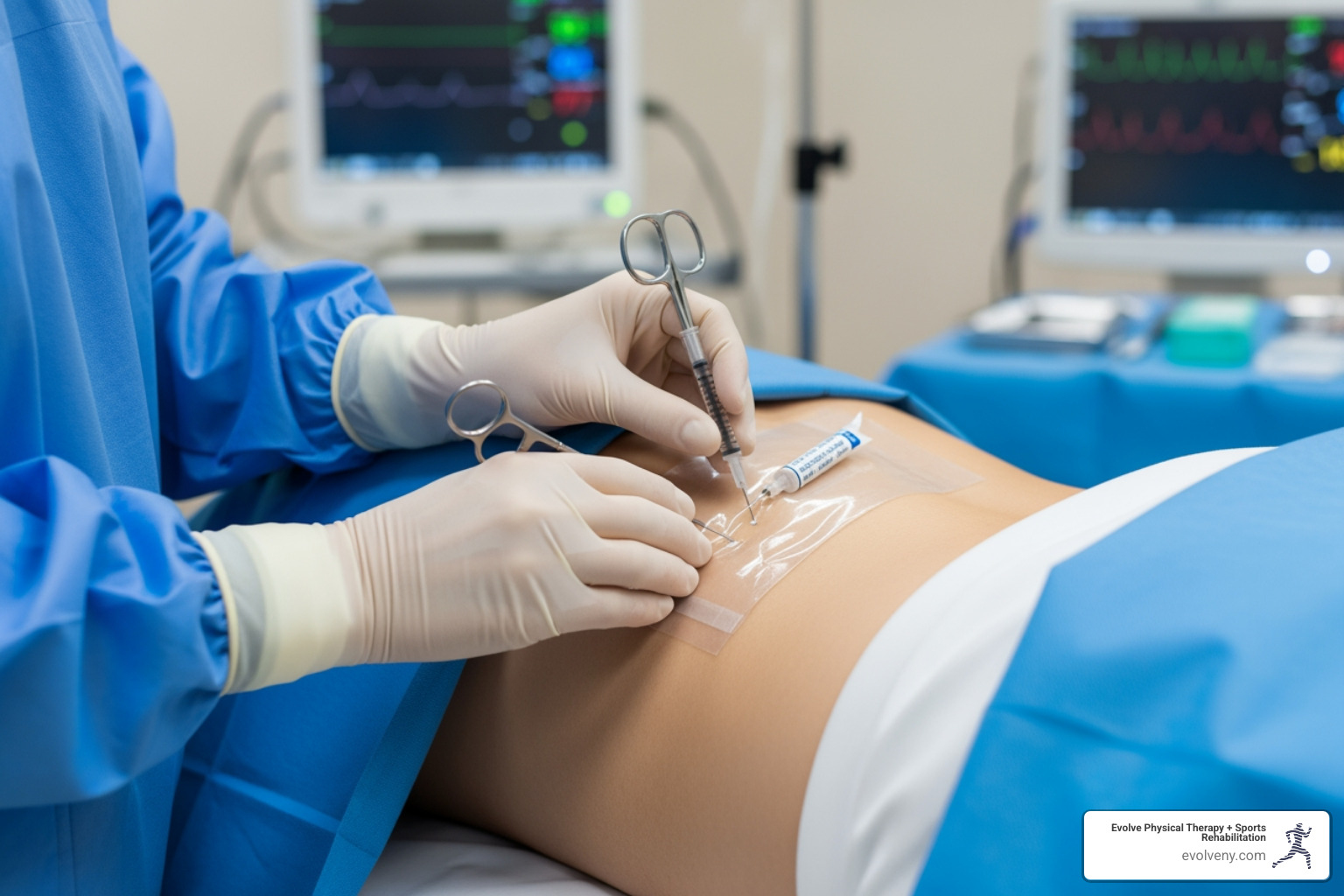
- Epidural Steroid Injections (ESIs): A corticosteroid is injected into the epidural space around the nerve roots. ESIs have success rates between 76% and 88% and create a window of pain relief ideal for making progress in physical therapy.
- Selective Nerve Root Blocks (SNRBs): A more targeted injection of a steroid-anesthetic mix around a specific nerve. They are both diagnostic and therapeutic, with success rates of around 75%.
Alternative and Complementary Therapies
Integrating other therapies can improve your recovery.
- Acupuncture: The pain-relieving benefits are evidence-supported, as it can trigger your body's natural pain-relief systems.
- Chiropractic Care: Spinal manipulation may help relieve nerve pressure for some individuals.
- Massage Therapy: Relaxes tense muscles, improves blood flow, and provides pain relief.
- Heat and Cold Therapy: Use ice packs initially to reduce inflammation, then switch to heat to relax muscles.
Our Physical Therapy and Pain Management approach integrates these methods for comprehensive care.
When Is Surgery Considered for a Herniated Disc?
Surgery is rarely the first option for pain management herniated disc treatment. It's typically considered only when specific criteria are met:
- Failure of conservative treatment: Pain and symptoms persist after six or more weeks of non-surgical care.
- Progressive neurological deficits: Increasing muscle weakness, numbness, or loss of sensation that impacts daily function.
- Cauda equina syndrome: A rare medical emergency causing loss of bladder/bowel control and severe numbness in the groin. This requires immediate surgical intervention.
- Intolerable pain: Severe pain that doesn't respond to other treatments and significantly impacts quality of life.
Microdiscectomy
This is the gold standard, accounting for approximately 90% of surgeries for this condition. A surgeon removes only the herniated portion of the disc pressing on the nerve. It is minimally invasive, and many patients go home the same day. Our specialized Rehab for Spinal Procedures Brooklyn supports recovery.
Laminectomy
In a laminectomy, the surgeon removes a portion of the lamina (the bony arch of the vertebra) to create more space for the nerves. This relieves pressure without removing disc material. Recovery time varies depending on whether the procedure is traditional or microscopic. Our Prehab for Spinal Procedures Brooklyn can help you prepare.
Spinal Fusion and Artificial Disc Replacement (ADR)
- Spinal Fusion: This procedure permanently joins two or more vertebrae to eliminate painful motion. It is less common for a simple herniated disc and is typically reserved for cases with spinal instability.
- Artificial Disc Replacement (ADR): A newer alternative to fusion, ADR involves replacing the damaged disc with an artificial one. The goal of ADR is to preserve movement in the spine, allowing for more natural mechanics and often a faster recovery than fusion.
Lifestyle Modifications and Self-Care for Long-Term Relief
The real secret to lasting pain management herniated disc success is about what you do every day. At Evolve Physical Therapy in Brooklyn, we empower patients with the knowledge to make smart lifestyle choices for long-term spinal health.
Key self-care strategies include:
- Patient Education: Understanding your condition, its cause, and your pain triggers is the first step toward taking control of your recovery.
- Ergonomics: If you sit at a desk, adjust your chair, monitor, and keyboard to reduce spinal strain. A lumbar support cushion can make a significant difference.
- Good Posture: Consciously maintaining good posture while sitting, standing, and walking distributes weight evenly and reduces pressure on your discs.
- Safe Lifting Techniques: Always bend at your knees, not your waist. Use your leg muscles to lift, keep the object close to your body, and never twist while lifting.
- Weight Management: Excess body weight, especially around the abdomen, adds stress to your lower back. Losing even a modest amount of weight can provide significant relief.
- Regular, Low-Impact Exercise: Activities like swimming, cycling, or walking strengthen the core muscles that support your spine without jarring it. For more guidance, check out our blog post: Low Back Pain: Why You Have It and How to Fix It.
- Stopping Smoking: Quitting smoking improves oxygen supply to your discs, which slows degeneration and promotes healing.
The prognosis for herniated discs is very positive, but there is a 20-25% chance of re-herniation. Committing to these lifestyle changes is your best defense against future pain.
Frequently Asked Questions about Herniated Disc Pain
Here are answers to common questions about pain management herniated disc treatment.
Can a herniated disc heal on its own?
Yes, most can. The body often reabsorbs the herniated disc material over time, relieving pressure on the nerve. This natural process, supported by conservative treatments like physical therapy, leads to significant improvement for most people within weeks to months. Our role at Evolve Physical Therapy is to create the optimal conditions for your body to heal itself.
What activities should be avoided with a herniated disc?
While staying active is crucial, you should temporarily modify certain movements to avoid re-injury. Avoid:
- High-impact sports: Running, jumping, and contact sports.
- Heavy lifting: This puts tremendous strain on your discs.
- Twisting motions: Such as swinging a golf club or reaching behind you.
- Prolonged sitting: This increases pressure on lumbar discs. Stand and move every 30 minutes.
- Bending at the waist: Always bend your knees and keep your back straight.
How long does pain from a herniated disc last?
The duration varies, but there are general patterns. With consistent conservative treatment, the acute pain for most people improves significantly within 6 to 12 weeks. Some may experience chronic or recurring pain, especially if the underlying issues aren't addressed. The key to lasting relief is a comprehensive strategy that includes physical therapy and lifestyle changes to build a strong, resilient spine.
Take Control of Your Herniated Disc Pain in Brooklyn
You don't have to live with the limitations of a herniated disc. The most important takeaway is that most people get better without surgery. Over 85% of acute symptoms resolve with conservative care like physical therapy and smart activity choices.
At Evolve Physical Therapy in Brooklyn, we see this happen every day for patients from Marine Park, Gravesend, Midwood, and Park Slope. We reject cookie-cutter approaches in favor of personalized pain management herniated disc strategies custom to your body and goals.
Physical therapy is the core of effective treatment. Through hands-on manual therapy, targeted strengthening, and patient education, we address your immediate pain and build long-term spinal health. The exercises you learn become your shield against future injury, helping you return to the activities you love.
Even if surgery becomes necessary, our specialized Prehab for Spinal Procedures Brooklyn and Rehab for Spinal Procedures Brooklyn programs support you at every step.
With the right guidance, you can return to your regular activities, often stronger than before. Our hands-on approach means we take the time to understand your unique pain and build a treatment plan for your real life.
Ready to take the first step? We're here in Brooklyn to create a plan that works for you.
Start your recovery with expert Physical Therapy for Herniated and Bulging Discs in Brooklyn

